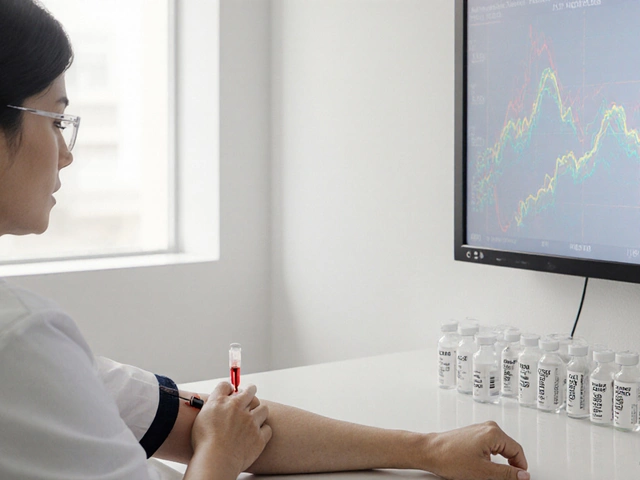Blood Test Result Interpreter
Enter your blood test values to see if they fall within normal ranges. This tool uses the medical standards from the full body blood test article. Values shown are based on common reference ranges for adults.
When you walk into a lab for a full body blood test, you’re not just giving a vial of blood-you’re giving your body a chance to speak. This single test can reveal hidden issues before symptoms show up. It’s not magic. It’s science. And it’s one of the most powerful tools you have to stay healthy, especially if you’re over 30, have a family history of chronic illness, or just want to know where you stand.
What’s Actually in a Full Body Blood Test?
A full body blood test isn’t one single test. It’s a group of tests bundled together to give a broad picture of your health. Most labs in India offer this as a standard package, and it usually includes 30 to 50 different measurements. The exact list varies by clinic, but the core components stay the same.
The test breaks down into five major groups: complete blood count, metabolic panel, lipid profile, liver and kidney function tests, and hormone and infection markers. Each tells a different story about what’s happening inside you.
Complete Blood Count (CBC): The Basic Snapshot
This is the most common blood test you’ll ever get. It checks your red blood cells, white blood cells, and platelets. Why does it matter?
- Red blood cells (RBC): Low levels mean anemia-common in women with heavy periods or people with poor iron intake. High levels can signal dehydration or lung issues.
- Hemoglobin: This protein carries oxygen. Normal range for men is 13-17 g/dL; for women, 12-16 g/dL. Below that, you’re likely tired, dizzy, or short of breath.
- White blood cells (WBC): These are your immune system’s soldiers. A high count often means infection or inflammation. A low count could point to autoimmune issues or bone marrow problems.
- Platelets: These help your blood clot. Too few? You bruise easily. Too many? Risk of clots.
Doctors look at these numbers together. A low hemoglobin with low MCV (mean corpuscular volume) usually means iron deficiency. A high WBC with high neutrophils? Likely bacterial infection.
Metabolic Panel: Sugar, Electrolytes, and Kidney Function
This group tells you how well your body handles energy and fluids. It includes fasting glucose, electrolytes, and kidney markers.
- Fasting blood sugar: Normal is under 100 mg/dL. Between 100-125? Prediabetes. Over 126? Diabetes. Many people in India have prediabetes without knowing it-especially if they eat refined carbs daily.
- Sodium, potassium, chloride: These electrolytes keep your nerves and muscles working. Too much sodium? Could mean high salt intake. Low potassium? Could cause muscle cramps or irregular heartbeat.
- Urea and creatinine: These are waste products your kidneys filter out. High levels mean your kidneys might be struggling. Normal creatinine for men is 0.7-1.3 mg/dL; for women, 0.6-1.1 mg/dL.
- Estimated Glomerular Filtration Rate (eGFR): This number estimates how well your kidneys are filtering. Below 60 for more than three months? Chronic kidney disease.
Many people ignore this part of the test. But a rising creatinine level over time is one of the earliest signs of kidney damage-often from uncontrolled diabetes or high blood pressure.
Lipid Profile: Cholesterol and Heart Risk
This test looks at fats in your blood. It’s not just about cholesterol-it’s about your risk for heart attack or stroke.
- Total cholesterol: Ideal is under 200 mg/dL. Over 240? High risk.
- LDL (bad cholesterol): Should be under 100 mg/dL. Over 160? You need lifestyle changes or medication.
- HDL (good cholesterol): Higher is better. Above 60 mg/dL is protective. Below 40 for men or 50 for women? Higher heart disease risk.
- Triglycerides: Normal is under 150 mg/dL. Over 200? Often tied to sugar, alcohol, or obesity.
Here’s what most people miss: HDL matters just as much as LDL. A person with normal LDL but low HDL can still have clogged arteries. That’s why doctors look at the total-to-HDL ratio. A ratio above 5 is a red flag.
Liver Function Tests: Is Your Liver Working?
Your liver processes everything you eat, drink, and take. It’s silent until it’s damaged.
- ALT and AST: These enzymes leak into blood when liver cells are hurt. Normal ALT is under 40 U/L. If ALT is higher than AST, it often points to fatty liver-common in people who drink soda daily or are overweight.
- Bilirubin: A yellow pigment from broken-down red blood cells. High levels cause jaundice. Normal is under 1.2 mg/dL.
- ALP and GGT: High levels can mean bile duct blockage or alcohol-related liver damage.
- Total protein and albumin: Low albumin can mean poor nutrition, liver disease, or kidney problems.
Many young Indians have fatty liver disease without symptoms. A simple blood test can catch it early. Left unchecked, it can turn into cirrhosis.
Hormones and Infection Markers: The Hidden Clues
This part varies by package, but most full body tests include a few key extras.
- TSH (Thyroid Stimulating Hormone): Normal is 0.4-4.0 mIU/L. Above 4.0? Could mean hypothyroidism-fatigue, weight gain, cold intolerance. Women over 40 are especially at risk.
- Vitamin D: Deficiency is rampant in India, even in sunny cities like Bangalore. Normal is 30-100 ng/mL. Below 20? You’re at higher risk for bone loss, depression, and infections.
- ESR and CRP: These measure inflammation. High levels mean something’s wrong-maybe arthritis, infection, or even early cancer.
- Hepatitis B and C screening: Often included. Both can be silent for years. Early detection saves lives.
People think they’re fine because they don’t feel sick. But thyroid issues and vitamin D deficiency are silent killers. They don’t cause pain-they cause burnout, weight gain, and brain fog.
Who Needs This Test and How Often?
You don’t need a full body blood test every year. But here’s when you should get one:
- Age 30+: Start baseline testing. Even if you feel fine.
- Family history of diabetes, heart disease, or cancer: Get tested every 1-2 years.
- Overweight or sedentary lifestyle: Fatty liver and prediabetes hide in plain sight.
- Chronic stress or poor sleep: These raise cortisol and inflammation markers.
- After a major life change: Marriage, new job, moving cities-these can trigger health shifts.
For healthy adults under 30 with no risk factors, every 2-3 years is fine. After 40, annual is ideal. If you’re on medication-like for blood pressure or cholesterol-your doctor may want it every 6 months.
What to Do After Getting Your Results
Getting your report back is just the start. The real work begins now.
- Don’t panic over one high number. A single elevated value can be due to stress, dehydration, or recent junk food. Repeat the test in 2-4 weeks.
- Compare with past results. Trends matter more than single numbers. Is your fasting sugar rising year after year? That’s a warning.
- Ask for context. Don’t just ask, “Is this normal?” Ask, “What does this mean for me?”
- Take action. If your vitamin D is low, get sunlight or take supplements. If your triglycerides are high, cut sugar and alcohol. If your liver enzymes are up, lose weight and stop drinking.
Most people get their report, see a few numbers are off, and do nothing. That’s the biggest mistake. A full body blood test is only useful if you act on it.

Common Misconceptions
- “I feel fine, so I don’t need it.” Many serious conditions-like early-stage diabetes or kidney disease-have zero symptoms until it’s too late.
- “Lab reports are always accurate.” No test is perfect. Fasting, stress, even the time of day can affect results. Always test under the same conditions.
- “More tests = better.” Some labs push unnecessary tests like cancer markers for healthy people. These can cause false alarms and stress. Stick to the core panel.
- “Only sick people need this.” Healthy people need it most. Prevention beats treatment every time.
How to Prepare for the Test
Small mistakes can ruin your results.
- Fasting for 8-12 hours is required for glucose and lipid tests. Water is fine. Coffee? No. Even black coffee can raise your blood sugar.
- Avoid heavy meals, alcohol, and intense exercise 24 hours before.
- Don’t take supplements or herbal medicines the morning of the test unless your doctor says yes.
- Stay hydrated. Dehydration can make your cholesterol and creatinine look higher than they are.
- Bring a list of medications you’re taking. Some drugs affect liver and kidney values.
Many people skip fasting because they think it won’t matter. It does. A single meal can spike your triglycerides by 50%.
Where to Get It Done in India
You don’t need to go to a hospital. Many reputable labs offer full body blood tests at affordable prices:
- Dr. Lal PathLabs - Standard package starts at ₹1,500-₹2,500
- Thyrocare - Known for accuracy, offers packages from ₹1,200
- Metropolis - Good for detailed reports and follow-up consultations
- SRL Diagnostics - Nationwide coverage, home sample collection
Most offer home collection. Book online, a technician comes to your door, and results come in 24-48 hours. Some even give you a free doctor consultation to explain the report.
Final Thought: Your Blood Is a Mirror
Your blood doesn’t lie. It shows what you’ve been eating, how you’ve been sleeping, how much stress you’re carrying, and whether your body is fighting something you can’t feel. A full body blood test is the closest thing we have to a health X-ray.
It’s not about fear. It’s about awareness. One test can change the course of your health. It might catch prediabetes before you need insulin. It might find a vitamin deficiency that’s been making you exhausted for years. It might reveal a liver problem you didn’t know you had.
Don’t wait for pain. Don’t wait for a diagnosis. Get tested. Know your numbers. Take control before it’s too late.
What is the normal range for fasting blood sugar in a full body blood test?
Normal fasting blood sugar is under 100 mg/dL. Between 100 and 125 mg/dL is prediabetes, and 126 mg/dL or higher on two tests means diabetes. Many people in India have prediabetes without symptoms, especially those who eat a lot of white rice, bread, or sweets.
How often should I get a full body blood test?
If you’re under 30 and healthy with no family history, every 3 years is fine. From age 30-40, every 2 years. After 40, annual testing is recommended. If you have risk factors like obesity, high blood pressure, or a family history of diabetes or heart disease, your doctor may suggest testing every 6-12 months.
Do I need to fast before a full body blood test?
Yes, you need to fast for 8-12 hours before the test. You can drink water, but avoid coffee, tea, soda, or any food. Fasting ensures accurate results for glucose, cholesterol, and triglyceride levels. Eating before the test can make your numbers look higher than they are.
Can a full body blood test detect cancer?
A standard full body blood test does not directly detect cancer. It can show signs that might suggest something’s wrong-like high inflammation (CRP), low red blood cells (anemia), or abnormal liver enzymes-but it can’t confirm cancer. Specific cancer screening tests like PSA for prostate or mammograms for breast cancer are needed for that. Don’t rely on a routine blood test for cancer diagnosis.
What does a high CRP level mean in a blood test?
High CRP (C-reactive protein) means there’s inflammation in your body. It could be from an infection, arthritis, obesity, smoking, or even chronic stress. Levels above 3 mg/L are considered high risk for heart disease. If your CRP is high and you have no symptoms, it’s a signal to check your diet, sleep, and activity levels.
Are home blood test kits reliable?
Yes, if they’re from reputable labs like Thyrocare, SRL, or Dr. Lal PathLabs. These companies use the same machines and protocols as hospitals. Home collection avoids stress-related spikes in blood pressure or cortisol that can affect results. Just make sure you follow fasting instructions and avoid taking supplements before the test.
Why is vitamin D tested in a full body blood panel?
Vitamin D deficiency is extremely common in India-even in sunny cities like Bangalore-because people avoid sun exposure, wear full clothing, or use sunscreen all day. Low vitamin D is linked to weak bones, fatigue, depression, and a weaker immune system. Testing helps catch this silent deficiency before it causes long-term damage.
Can a full body blood test detect thyroid problems?
Yes, if the panel includes TSH (Thyroid Stimulating Hormone). TSH levels above 4.0 mIU/L often indicate hypothyroidism, which causes fatigue, weight gain, dry skin, and cold intolerance. Women over 40 are especially prone. Many people mistake these symptoms for stress or aging-until they get tested.
What should I do if my cholesterol is high?
Start with diet changes: cut down on fried foods, processed snacks, and sugar. Eat more oats, nuts, beans, and green vegetables. Walk 30 minutes a day. If your LDL is above 160 or you have other risk factors like high blood pressure or diabetes, your doctor may recommend statins. Don’t ignore it-high cholesterol silently damages your arteries.
Is a full body blood test worth the cost?
Absolutely. A basic package costs between ₹1,200 and ₹2,500. That’s less than a week’s worth of coffee or junk food. But it can catch diabetes, liver disease, or kidney problems before they turn into expensive hospital bills. Prevention saves money, time, and pain. Think of it as insurance for your future health.
If you’ve never had a full body blood test, schedule one this month. It’s the simplest, most powerful step you can take toward a longer, healthier life.






